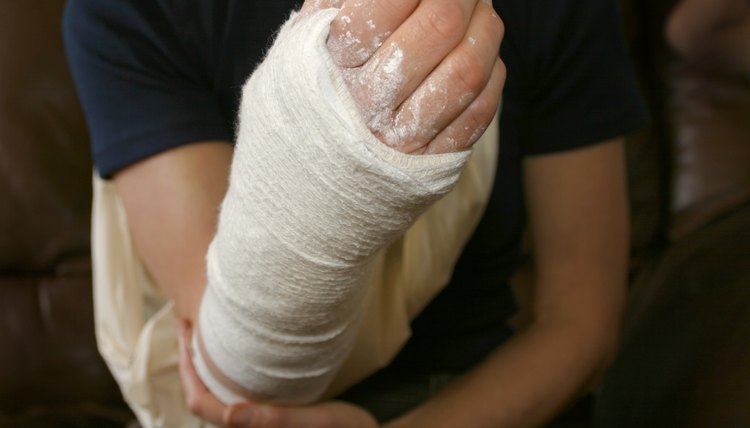What Do I Put Over a Right Arm Cast to Play Soccer?

Famous soccer players who have played with a cast on their right arm include Chelsea forward Didier Drogba, who represented his home nation, the Ivory Coast, in the 2010 World Cup. Drogba wore a soft cast under a long-sleeved shirt in the wake of an injury days earlier. England forward Gary Lineker wore a soft cast in the 1986 World Cup and poured in six goals. If you have the misfortune to break your arm, you need to know what you can put over the cast to allow you to return safely to the field.
High Schools
The National Federation of State High School Associations requires a right-arm hard cast to be covered on all surfaces with high-density, closed-cell polyurethane no less than ½ inch thick or an alternative similar material. A physician needs to sign a medical release, and the player needs to provide the release to the referee at the field. Vendors of sports medicine equipment sell kits containing sheets of foam to cover casts; the foam meets the federation standards.
Inspection
If you are not a high school player, you should familiarize yourself with possible obstacles to returning to the field while you are wearing a cast. Law 4 of the Laws of the Game promulgated by FIFA, the international governing body of soccer, states that the referee must inspect and approve clothing or equipment other than basic equipment. U.S. Youth Soccer, with 3 million youth players, permits players with casts to take the field if the cast cover is inspected and approved by the referee.
Prohibitions
Youth soccer leagues in certain states, including Texas and Wisconsin, prohibit players with casts from playing altogether. According to AsktheRef.com, these states do not allow referee discretion, based on concerns that the cast can severely injure other players. Also, the American Youth Soccer Organization, with 650,000 youth players, does not allow players to practice or participate while wearing a cast or splint; removal of a cast or splint at the field or nearby will disqualify the player.
Coverings
If wearing a cast is permitted, the referee will need to approve the type of cast covering. Typical coverings in addition to foam include bubble wrap, carpet, an elastic bandage or, if you are unprepared, a T-shirt and tape. While often used, bubble wrap may cause the right arm to sweat too much in hot weather. In addition to a covering, state soccer referee associations may follow Vermont's example and require a medical release or a doctor’s note allowing you to play with a broken arm -- more likely to be granted to a field player than a goalkeeper. Further, you must agree not to use the cast in a way that is dangerous, especially near the heads of other players. A referee may remove a player who swings the cast around like a club.
References
Writer Bio
An award-winning writer and editor, Rogue Parrish has worked at the Washington Post, the Baltimore Sun and at newspapers from England to Alaska. This world adventurer and travel book author, who graduates summa cum laude in journalism from the University of Maryland, specializes in travel and food -- as well as sports and fitness. She's also a property manager and writes on DIY projects.
